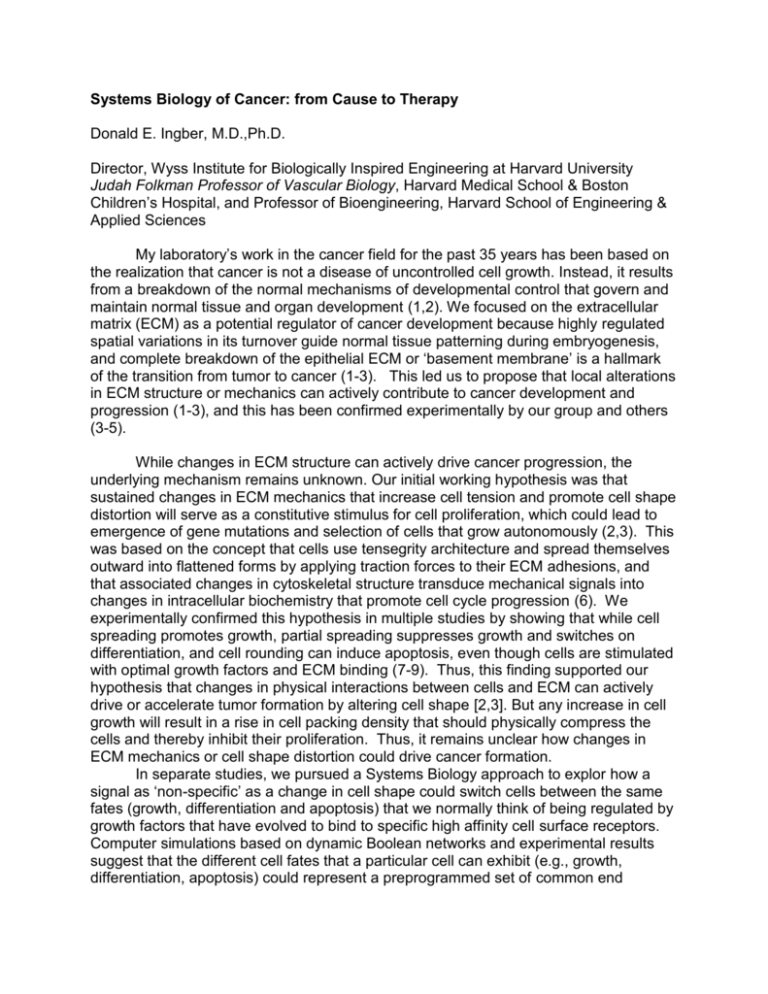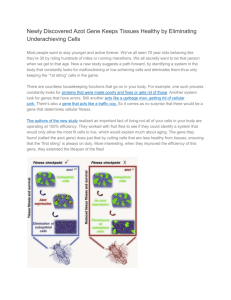Systems Biology of Cancer: From Cause to Therapy
advertisement

Systems Biology of Cancer: from Cause to Therapy Donald E. Ingber, M.D.,Ph.D. Director, Wyss Institute for Biologically Inspired Engineering at Harvard University Judah Folkman Professor of Vascular Biology, Harvard Medical School & Boston Children’s Hospital, and Professor of Bioengineering, Harvard School of Engineering & Applied Sciences My laboratory’s work in the cancer field for the past 35 years has been based on the realization that cancer is not a disease of uncontrolled cell growth. Instead, it results from a breakdown of the normal mechanisms of developmental control that govern and maintain normal tissue and organ development (1,2). We focused on the extracellular matrix (ECM) as a potential regulator of cancer development because highly regulated spatial variations in its turnover guide normal tissue patterning during embryogenesis, and complete breakdown of the epithelial ECM or ‘basement membrane’ is a hallmark of the transition from tumor to cancer (1-3). This led us to propose that local alterations in ECM structure or mechanics can actively contribute to cancer development and progression (1-3), and this has been confirmed experimentally by our group and others (3-5). While changes in ECM structure can actively drive cancer progression, the underlying mechanism remains unknown. Our initial working hypothesis was that sustained changes in ECM mechanics that increase cell tension and promote cell shape distortion will serve as a constitutive stimulus for cell proliferation, which could lead to emergence of gene mutations and selection of cells that grow autonomously (2,3). This was based on the concept that cells use tensegrity architecture and spread themselves outward into flattened forms by applying traction forces to their ECM adhesions, and that associated changes in cytoskeletal structure transduce mechanical signals into changes in intracellular biochemistry that promote cell cycle progression (6). We experimentally confirmed this hypothesis in multiple studies by showing that while cell spreading promotes growth, partial spreading suppresses growth and switches on differentiation, and cell rounding can induce apoptosis, even though cells are stimulated with optimal growth factors and ECM binding (7-9). Thus, this finding supported our hypothesis that changes in physical interactions between cells and ECM can actively drive or accelerate tumor formation by altering cell shape [2,3]. But any increase in cell growth will result in a rise in cell packing density that should physically compress the cells and thereby inhibit their proliferation. Thus, it remains unclear how changes in ECM mechanics or cell shape distortion could drive cancer formation. In separate studies, we pursued a Systems Biology approach to explor how a signal as ‘non-specific’ as a change in cell shape could switch cells between the same fates (growth, differentiation and apoptosis) that we normally think of being regulated by growth factors that have evolved to bind to specific high affinity cell surface receptors. Computer simulations based on dynamic Boolean networks and experimental results suggest that the different cell fates that a particular cell can exhibit (e.g., growth, differentiation, apoptosis) could represent a preprogrammed set of common end programs or “attractors” which self-organize within the cell’s gene regulatory network (10). To explore this we carried out gene expression profiling in human promyelocytic HL60 cells that were induced to differentiate into neutrophils using either a specific chemical factor (trans-retinoic acid) or a non-specific stimulus (DMSO). Our results revealed that trajectories of neutrophil differentiation converge to a common state from different directions of a 2773-dimensional gene expression state space; this provided the first experimental evidence for a high-dimensional stable attractor that represents a distinct cellular phenotype (11). As cell states represent attractors in the geneome-wide gene regulatory network, then control of cell behavior involves selection of preexisting behavioral modes of the cell. If this is the case, then cell fate switching also should be able to be induced by genetic noise (i.e., stochastic variations in gene expression profiles), and we confirmed this experimentally as well (12). Gene expression stochasticity governs transitions between different fates because while network dynamics driven by specific stimuli tend to drive a cell to a local attractor in state space, transitions between attractors can occur when noise pushes the cell out of one basin of attraction and into another. Importantly, we recently explored if cancer formation could be driven by changes in cell shape that lead to increases in genetic noise, given that both factors have been independently shown to alter gene expression and induce cell fate switching. Importantly, loss of regularity of cell shape and position are hallmarks of cancer progression, and tumor formation is accompanied by a progressive loss of normal shape-dependent controls over cell growth, differentiation and survival. In addition, the fidelity of genetic control is tightly coupled to nuclear and chromatin structure, which in turn are sensitive to cytoskeletal structure and cell shape regulation. Thus, increases in cell shape variation that occur during early stages of tumor formation could potentially trigger cell fate transitions that drive carcinogenesis both by harnessing mechanical signaling pathways and enhancing genetic variability. Using a computer simulation model, we explored the impact of physical changes in the tissue microenvironment under conditions in which physical deformation of cells increases gene expression variability among genetically identical cells. The model revealed that cancerous tissue growth can be driven by physical changes in the microenvironment: when increases in cell shape variability due to growth-dependent increases in cell packing density enhance gene expression variation, heterogeneous autonomous growth and further structural disorganization can result, thereby driving cancer progression via positive feedback (13). The model parameters that led to this prediction also were consistent with experimental measurements of mammary tissues that spontaneously undergo breast cancer progression in transgenic C3(1)-SV40Tag female mice. Interestingly, mammary glands in these mice also exhibit enhanced stiffness of mammary ducts, as well as progressive increases in variability of cell-cell relations and associated cell shape changes. These findings support the concept that physical changes in the tissue microenvironment (e.g., altered ECM mechanics) can promote cancer formation or accelerate cancer progression in a clonal population through local changes in cell shape and increased phenotypic variability, even in the absence of gene mutation. Given the importance of network-wide non-linear dynamics for cell fate switching and cancer development, we recently teamed with Jim Collin’s group at the Wyss Institute and Boston University to use another computational Systems Biology approach to evaluate gene expression changes in context of the entire gene regulatory network during mammary cancer formation in the transgenic C3(1)-SV40Tag mouse model. We constructed models of gene regulatory network connectivity with the Mode-of-action by Network Identification tool (14). This tool was first trained on 3,000 gene microarray datasets from various mouse tissues and organs under diverse conditions to develop a basal gene regulatory network connectivity model. This is a directed graph that relates the concentration of each gene transcript to that of every other transcript across the genome. Genes are connected in this network if the activity of one gene influences the transcriptional state of the other, regardless of whether the effect occurs at transcriptional or post-transcriptional levels and independently of the type or directionality of the interaction. The trained gene network model was then tested with transgenic and wild type mammary gland transcriptome data to identify the earliest changes that rewire the gene regulatory network during tumor formation. In female transgenic mice, breast tumor formation progresses in a highly reproducible manner, with hyperplasia first appearing at ~ 12 weeks of age, DCIS-like lesions at ~ 16 weeks, and invasive carcinomas at 20 weeks (15). To focus on early events in tumorigenesis, whole genome transcriptome profiles were obtained for mammary glands isolated from 8 week-old transgenic mice when the transgene is highly expressed, but the glands remain histologically normal. Candidate transcription factors were ranked and the HoxA1 gene emerged as a highly significant potential key mediator of early cancer progression. Importantly, silencing this gene in cultured mouse or human mammary tumor spheroids using siRNA, resulted in increased acinar lumen formation, reduced tumor cell proliferation, and restoration of normal epithelial polarization. When the HoxA1 gene was silenced in vivo via intraductal delivery of nanoparticle-formulated siRNA through the nipple of transgenic mice with early stage disease, tumor incidence was significantly reduced (15). These are just some of the examples of how systems biology can be applied to attack the cancer problem from analysis of causal mechanisms to development of novel therapeutics. REFERENCES 1. 2. 3. 4. Ingber DE, Jamieson JD. Cells as tensegrity structures: architectural regulation of histodifferentiation by physical forces tranduced over basement membrane. In: Andersson LC,Gahmberg CG, Ekblom P, eds. Gene Expression During Normal and Malignant Differentiation. Orlando: Academic Press; 1985; 13-32. Ingber DE. Cancer as a disease of epithelia-mesenchymal interactions and extracellular matrix regulation. Differentiation 2002; 70: 547-560. Ingber DE, Madri JA, Jamieson JD. Role of basal lamina in the neoplastic disorganization of tissue architecture. Proc. Natl. Acad. Sci. U.S.A. 1981; 78:39013905. Sternlicht MD, Bissell MJ, Werb Z. The matrix metalloproteinase stromelysin-1 acts as a natural mammary tumor promoter. Oncogene 2000; 19: 1102-1113. 5. 6. 7. 8. 9. 10. 11. 12. 13. 14. 15. Paszek MJ, Zahir N, Johnson KR, Lakins JN, Rozenberg GI, Gefen A, ReinhartKing CA, Margulies SS, Dembo M, Boettiger D, Hammer DA, Weaver VM. Tensional homeostasis and the malignant phenotype. Cancer Cell 2005; 8:241-54. Ingber, DE. Cellular Tensegrity: defining new rules of biological design that govern the cytoskeleton. J. Cell Sci. 1993; 104:613-627. Singhvi R, Kumar A, Lopez G, Stephanopoulos GN, Wang DIC, Whitesides GM, Ingber DE. Engineering cell shape and function. Science 1994; 264:696-698. Chen CS, Mrksich M, Huang S, Whitesides G, Ingber DE. Geometric control of cell life and death. Science 1997; 276:1425-1428. Mammoto A, Huang S, Moore K, Oh P and Ingber DE. Role of RhoA, mDia, and ROCK in cell shape-dependent control of the Skp2-p27kip1 pathway and the G1/S transition. J. Biol. Chem. 2004; 279: 26323-25330. Huang S, Ingber DE. Shape-dependent control of cell growth, differentiation, and apoptosis: switching between attractors in cell regulatory networks. Exp Cell Res 2000; 261: 91-103. Huang S, Eichler G, Bar-Yam Y, Ingber DE. Cell fates as attractors in gene expression state space. Phys. Rev. Lett. 2005; 94: 128701-12802. Chang H, Hemberg M, Barahona M, Ingber DE and Huang S. Transcriptome-wide noise controls differentiation potential of mammalian progenitor cells. Nature 2008 453:544-7. Werfel J, Krause S, Bischof AG, Mannix RJ, Tobin H, Bar-Yam Y, Bellin RM and Ingber DE. How Changes in Extracellular Matrix Mechanics and Genetic Noise Might Combine to Drive Cancer Progression. PLoS ONE 2013; 8: e76122. D. di Bernardo et al., Chemogenomic profiling on a genome-wide scale using reverse-engineered gene networks. Nat Biotechnol 2005; 23, 377. Brock A, Krause S, Li H, Kowalski M, Goldberg MS, Collins JJ, Ingber DE.Silencing HoxA1 by Intraductal Injection of siRNA Lipidoid Nanoparticles Prevents Mammary Tumor Progression in Mice. Sci. Trans. Med. 2014; 6:217ra2.









